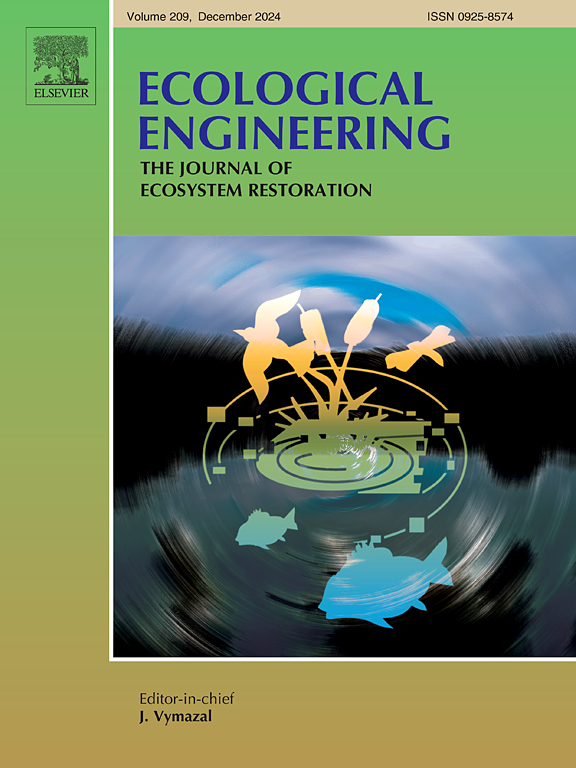On the influence of plant morphology in the extensive green roof cover: A case study in Mediterranean area
IF 3.9
2区 环境科学与生态学
Q1 ECOLOGY
引用次数: 0
Abstract
The success of green roofs in Mediterranean areas requires the selection of fast development plant species, able to grow in a shallow soilless substrate also under dry climatic conditions. In this context, the exploitation of native species from marginal sites characterized by limited availability of nutrients and water could be a strategy to select plants. In this work, various species, belonging to the Crassulaceae family from Central Mediterranean and sub-tropical regions, have been evaluated for their growth performance on extensive green roofs outdoor in Central Italy in mono and mixed culture. The morphology, i.e. branched or rosette type, resulted a fundamental trait for the coverage and species with prostrate branches, presented higher plant cover in the first year after transplant respect to the “rosette” type in monoculture. In particular, the Mediterranean native branched species S. album, S. rupestre, S. sediforme and the “rosette” Sempervivum tectorum presented a good performance under the seasonal variations, with high cover ability or biomass production after 15 months. In the mixed cultures, these species presented a different performance. S. album resulted highly competitive and “aggressive spreaders” respect to the other Sedums and may be suitable for monoculture or in combination with low covering shrub species. Among the “rosette” species, the allochthonous subtropical Aeonium castello paivae Bolle presented a good surface coverage and biomass production respect to the branched species while the native Sempervivum tectorum (Griseb. & Schenk) L. presented low covering ability in all the combinations. However, the introduction of “rosette” species in combination with “branched” ones (Sedums) could increase the diversity and aesthetic appearance of the roof.
大面积屋顶绿化对植物形态的影响——以地中海地区为例
地中海地区绿色屋顶的成功需要选择快速生长的植物物种,能够在干燥的气候条件下在浅层无土基质中生长。在这种情况下,从营养和水供应有限的边缘地点开发本地物种可能是一种选择植物的策略。在这项工作中,我们对来自地中海中部和亚热带地区的不同种类的天竺葵科植物在意大利中部广泛的室外绿色屋顶上的单一和混合栽培的生长性能进行了评估。分枝型或莲座型是盖度的一个基本特征,枝条匍匐的物种在移栽后1年的盖度高于单栽的“莲座”型。其中,地中海本土支种S. album、S. rupestre、S. sediforme和“rossette”Sempervivum tectorum在季节变化下表现较好,15个月后具有较高的覆盖能力或生物量产量。在混合培养中,这些物种表现出不同的表现。与其他景天属植物相比,这一品种具有很强的竞争力和“侵略性”,适合单作或与低盖度灌木物种组合。在“莲座”种中,外来的亚热带Aeonium castello paivae Bolle表现出较好的地表覆盖度和生物量,而本地的Sempervivum tectorum (Griseb。,申克(Schenk) L.在所有组合中覆盖能力都较低。然而,引入“莲座”物种与“分枝”物种(Sedums)相结合,可以增加屋顶的多样性和美观。
本文章由计算机程序翻译,如有差异,请以英文原文为准。
求助全文
约1分钟内获得全文
求助全文
来源期刊

Ecological Engineering
环境科学-工程:环境
CiteScore
8.00
自引率
5.30%
发文量
293
审稿时长
57 days
期刊介绍:
Ecological engineering has been defined as the design of ecosystems for the mutual benefit of humans and nature. The journal is meant for ecologists who, because of their research interests or occupation, are involved in designing, monitoring, or restoring ecosystems, and can serve as a bridge between ecologists and engineers.
Specific topics covered in the journal include: habitat reconstruction; ecotechnology; synthetic ecology; bioengineering; restoration ecology; ecology conservation; ecosystem rehabilitation; stream and river restoration; reclamation ecology; non-renewable resource conservation. Descriptions of specific applications of ecological engineering are acceptable only when situated within context of adding novelty to current research and emphasizing ecosystem restoration. We do not accept purely descriptive reports on ecosystem structures (such as vegetation surveys), purely physical assessment of materials that can be used for ecological restoration, small-model studies carried out in the laboratory or greenhouse with artificial (waste)water or crop studies, or case studies on conventional wastewater treatment and eutrophication that do not offer an ecosystem restoration approach within the paper.
 求助内容:
求助内容: 应助结果提醒方式:
应助结果提醒方式:


